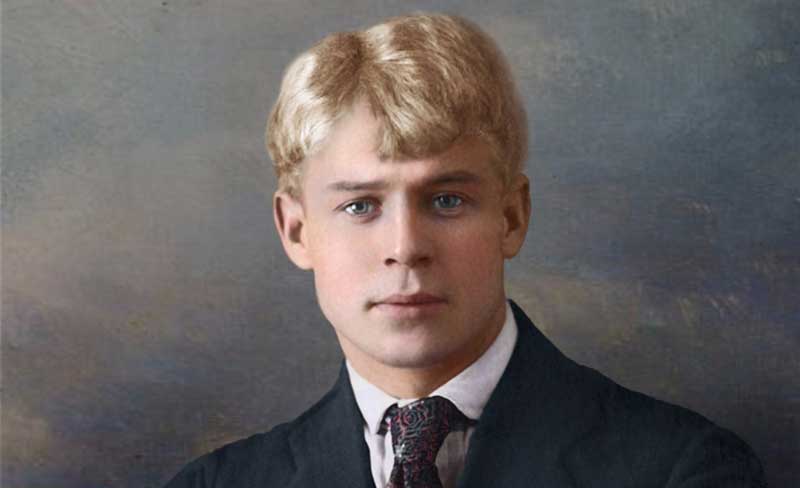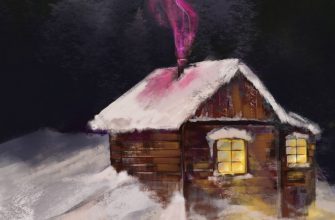English2017
Английский для всех простым языком
Сергей Есенин — биография на английском с переводом

Sergey Yesenin Autobiography
In 1904 Yesenin joined the Konstantinovo zemstvo school. In 1909 he graduated it with an honorary certificate, and went on to study in the local secondary parochial school in Spas-Klepiki. From 1910 onwards, he started to write poetry systematically; In all, Yesenin wrote around thirty poems during his school years. He compiled them into what was supposed to be his first book which he titled «Bolnye Dumy» — Sick Thoughts — and tried to publish it in 1912 in Ryazan, but failed.
He left his village at 17 for Moscow and later Petrograd (subsequently Leningrad, now St. Petersburg). In the cities he became acquainted with Aleksandr Blok, the peasant poet Nikolay Klyuyev, and revolutionary politics.
Yesenin’s first marriage (which lasted three years) was in 1913 to Anna Izryadnova, a co-worker from the publishing house, with whom he had a son, Yuri. 1913 saw Yesenin becoming increasingly interested in Christianity, biblical motives became frequent in his poems. That was also the year when he became involved with the Moscow revolutionary circles: for several months his flat was under secret police surveillance and in September 1913 it was raided and searched.
In 1916 he published his first book, characteristically titled for a religious feast day, Radunitsa (“Ritual for the Dead”).
From 1916 to 1917, Yesenin was drafted into military duty
In August 1917 Yesenin married for a second time, to Zinaida Raikh. They had two children, a daughter Tatyana and a son Konstantin. Tatyana became a writer and journalist and Konstantin Yesenin would become a well-known soccer statistician.
Yesenin supported the February Revolution. Later he criticized the Bolshevik rule.
In 1922 he married the American dancer Isadora Duncan. They visited the United States, their quarrels duly observed in the world press. On their separation Yesenin returned to Russia.
Yesenin married again, a granddaughter of Tolstoy, but continued to drink heavily and to take cocaine.
In 1925 he was briefly hospitalized for a nervous breakdown.
Died December 27, 1925 in St. Petersburg, Russia. On 28th December 1925, Yesenin was found dead in the room in the Hotel Angleterre in St Petersburg. He was buried December 31, 1925, in Moscow’s Vagankovskoye Cemetery. His grave is marked by a white marble sculpture.
He was a prolific and somewhat uneven writer. His poignant short lyrics are full of striking imagery. He was very popular both during his lifetime and after his death.
Перевод
В 1904 году Есенин вступил в Константиновское земское училище. В 1909 году закончил его с почетным дипломом и продолжил обучение в местной средней приходской школе в Спас-Клепики. С 1910 года начал писать стихи на постоянной основе. В целом, в школьные годы Есенин написал около тридцати стихотворений. Он собрал их в его первую книгу, которую назвал «Больные думы», пытался опубликовать книгу в 1912 году в Рязани, но потерпел неудачу.
В 17 лет он уехал из деревни в Москву, а затем в Петроград, впоследствии Ленинград, ныне Санкт-Петербург. Там он познакомился с Александром Блоком, крестьянином Николаем Клюевым и революционной политикой.
Первый брак Есенина, который длился три года, был в 1913 году с Анной Изрядновой, сотрудником издательства, с которой у него был сын Юрий. В 1913 году Есенин все больше интересовался христианством, в его стихах часто возникали библейские мотивы. Это был также год, когда он стал участвовать в московских революционных кругах: в течение нескольких месяцев его квартира находилась под наблюдением секретной полиции, а в сентябре 1913 года она подвергалась набегам и обыскам.
В 1916 году он опубликовал свою первую книгу, характерно названную для религиозного праздника Радуница — «Ритуал для мертвых».
С 1916 по 1917 год Есенин был призван в военную службу.
В августе 1917 года Есенин женился второй раз, на Зинаиде Райх. У них было двое детей, дочь Татьяна и сын Константин. Татьяна стала писателем и журналистом, а Константин Есенин станет известным футболистом-статистиком.
Есенин поддержал Февральскую революцию. Позже он подверг критике большевистское правление.
В 1920-21 годах он сочинил свою длинную поэтическую драму про Пугачева, прославляющую повстанца 18-го века.
Вскоре он стал ведущим лидером школы. Он стал завсегдатаем литературных кафе Москвы, где читал стихи и много пил.
В 1922 году он женился на американской танцовщице Айседоре Дункан. Они посетили Соединенные Штаты. Их ссоры отражались мировой прессой. После их развода Есенин вернулся в Россию.
Умер 27 декабря 1925 года в Санкт-Петербурге, Россия. 28 декабря 1925 года Есенин был найден мертвым в комнате в гостинице «Англетер» в Санкт-Петербурге. Был похоронен 31 декабря 1925 года на Ваганьковском кладбище в Москве. На его могиле белая мраморная скульптура.
Он был одаренным и неоднозначным писателем. Его острая короткая лирика полна ярких образов. Он был очень популярен как во время его жизни, так и после его смерти.
Sergey Aleksandrovich Yesenin
Our editors will review what you’ve submitted and determine whether to revise the article.
Sergey Aleksandrovich Yesenin, Yesenin also spelled Esenin, (born Oct. 3 [Sept. 21, Old Style], 1895, Konstantinovo, Ryazan province, Russia—died Dec. 27, 1925, Leningrad), the self-styled “last poet of wooden Russia,” whose dual image—that of a devout and simple peasant singer and that of a rowdy and blasphemous exhibitionist—reflects his tragic maladjustment to the changing world of the revolutionary era.
The son of a peasant family of Old Believers, he left his village at 17 for Moscow and later Petrograd (subsequently Leningrad, now St. Petersburg). In the cities he became acquainted with Aleksandr Blok, the peasant poet Nikolay Klyuyev, and revolutionary politics. In 1916 he published his first book, characteristically titled for a religious feast day, Radunitsa (“Ritual for the Dead”). It celebrates in church book imagery the “wooden Russia” of his childhood, a world blessed by saints in painted icons, where storks nest in chimneys and the sky above the birch trees is a bright blue scarf.
Yesenin welcomed the Revolution as the social and spiritual transformation that would lead to the peasant millennium he envisioned in his next book, Inoniya (1918; “Otherland”). His roseate utopian view of Otherland was still informed by a simple ethos—the defense of “wooden things” against the vile world of iron, stone, and steel (urban industrialization). In 1920–21 he composed his long poetic drama Pugachyov, glorifying the 18th-century rebel who led a mass peasant revolt during the reign of Catherine II. In 1919 he signed the literary manifesto of the group of Russian poets called the Imaginists (see Imaginism). He was soon the leading exponent of the school. He became a habitué of the literary cafés of Moscow, where he gave poetry recitals and drank excessively. A marriage to Zinaida Reich (later the wife of the actor-director Vsevolod Meyerhold) ended in divorce. In 1922 he married the American dancer Isadora Duncan and accompanied her on tour, during which he smashed suites in the best hotels in Europe in drunken rampages. They visited the United States, their quarrels and public scenes duly observed in the world press. On their separation Yesenin returned to Russia. For some time he had been writing the consciously cynical, swaggering tavern poetry that appeared in Ispoved khuligana (1921; “Confessions of a Hooligan”) and Moskva kabatskaya (1924; “Moscow of the Taverns”). His verse barely concealed the sense of self-depreciation that was overwhelming him. He married again, a granddaughter of Tolstoy, but continued to drink heavily and to take cocaine. In 1924 he tried to go home again but found the village peasants quoting Soviet slogans, when he himself had not been able to read five pages of Marx. Tormented by guilt that he had been unable to fulfill the messianic role of poet of the people, he tried to get in step with the national trend. In the poem “Neuyutnaya zhidkaya lunnost” (1925; “Desolate and Pale Moonlight”), he went so far as to praise stone and steel as the secret of Russia’s coming strength. But another poem, “The Stern October Has Deceived Me,” bluntly voiced his alienation from Bolshevik Russia. His last major work, the confessional poem “Cherny chelovek” (“The Black Man”), is a ruthless self-castigation for his failures. In 1925 he was briefly hospitalized for a nervous breakdown. Soon after, he hanged himself in a Leningrad hotel, having written his last lines in his own blood.
A prolific and somewhat uneven writer, Yesenin had a true gift of song. His poignant short lyrics are full of striking imagery. He was very popular both during his lifetime and after his death. Frowned on by Communist critics and party leaders, who feared the debilitating effect of “Yeseninism” on the civic dedication of the young, he was long more or less out of official favour. Editions of his work that became available (1956–60) attested to his continued popularity. His complete works were published in 1966–68.
Рассказ про есенина на английском языке с переводом
English2017
Английский для всех простым языком
Сергей Есенин — биография на английском с переводом

Sergey Yesenin Autobiography
In 1904 Yesenin joined the Konstantinovo zemstvo school. In 1909 he graduated it with an honorary certificate, and went on to study in the local secondary parochial school in Spas-Klepiki. From 1910 onwards, he started to write poetry systematically; In all, Yesenin wrote around thirty poems during his school years. He compiled them into what was supposed to be his first book which he titled «Bolnye Dumy» — Sick Thoughts — and tried to publish it in 1912 in Ryazan, but failed.
He left his village at 17 for Moscow and later Petrograd (subsequently Leningrad, now St. Petersburg). In the cities he became acquainted with Aleksandr Blok, the peasant poet Nikolay Klyuyev, and revolutionary politics.
Yesenin’s first marriage (which lasted three years) was in 1913 to Anna Izryadnova, a co-worker from the publishing house, with whom he had a son, Yuri. 1913 saw Yesenin becoming increasingly interested in Christianity, biblical motives became frequent in his poems. That was also the year when he became involved with the Moscow revolutionary circles: for several months his flat was under secret police surveillance and in September 1913 it was raided and searched.
In 1916 he published his first book, characteristically titled for a religious feast day, Radunitsa (“Ritual for the Dead”).
From 1916 to 1917, Yesenin was drafted into military duty
In August 1917 Yesenin married for a second time, to Zinaida Raikh. They had two children, a daughter Tatyana and a son Konstantin. Tatyana became a writer and journalist and Konstantin Yesenin would become a well-known soccer statistician.
Yesenin supported the February Revolution. Later he criticized the Bolshevik rule.
In 1922 he married the American dancer Isadora Duncan. They visited the United States, their quarrels duly observed in the world press. On their separation Yesenin returned to Russia.
Yesenin married again, a granddaughter of Tolstoy, but continued to drink heavily and to take cocaine.
In 1925 he was briefly hospitalized for a nervous breakdown.
Died December 27, 1925 in St. Petersburg, Russia. On 28th December 1925, Yesenin was found dead in the room in the Hotel Angleterre in St Petersburg. He was buried December 31, 1925, in Moscow’s Vagankovskoye Cemetery. His grave is marked by a white marble sculpture.
He was a prolific and somewhat uneven writer. His poignant short lyrics are full of striking imagery. He was very popular both during his lifetime and after his death.
Перевод
В 1904 году Есенин вступил в Константиновское земское училище. В 1909 году закончил его с почетным дипломом и продолжил обучение в местной средней приходской школе в Спас-Клепики. С 1910 года начал писать стихи на постоянной основе. В целом, в школьные годы Есенин написал около тридцати стихотворений. Он собрал их в его первую книгу, которую назвал «Больные думы», пытался опубликовать книгу в 1912 году в Рязани, но потерпел неудачу.
В 17 лет он уехал из деревни в Москву, а затем в Петроград, впоследствии Ленинград, ныне Санкт-Петербург. Там он познакомился с Александром Блоком, крестьянином Николаем Клюевым и революционной политикой.
Первый брак Есенина, который длился три года, был в 1913 году с Анной Изрядновой, сотрудником издательства, с которой у него был сын Юрий. В 1913 году Есенин все больше интересовался христианством, в его стихах часто возникали библейские мотивы. Это был также год, когда он стал участвовать в московских революционных кругах: в течение нескольких месяцев его квартира находилась под наблюдением секретной полиции, а в сентябре 1913 года она подвергалась набегам и обыскам.
В 1916 году он опубликовал свою первую книгу, характерно названную для религиозного праздника Радуница — «Ритуал для мертвых».
С 1916 по 1917 год Есенин был призван в военную службу.
В августе 1917 года Есенин женился второй раз, на Зинаиде Райх. У них было двое детей, дочь Татьяна и сын Константин. Татьяна стала писателем и журналистом, а Константин Есенин станет известным футболистом-статистиком.
Есенин поддержал Февральскую революцию. Позже он подверг критике большевистское правление.
В 1920-21 годах он сочинил свою длинную поэтическую драму про Пугачева, прославляющую повстанца 18-го века.
Вскоре он стал ведущим лидером школы. Он стал завсегдатаем литературных кафе Москвы, где читал стихи и много пил.
В 1922 году он женился на американской танцовщице Айседоре Дункан. Они посетили Соединенные Штаты. Их ссоры отражались мировой прессой. После их развода Есенин вернулся в Россию.
Умер 27 декабря 1925 года в Санкт-Петербурге, Россия. 28 декабря 1925 года Есенин был найден мертвым в комнате в гостинице «Англетер» в Санкт-Петербурге. Был похоронен 31 декабря 1925 года на Ваганьковском кладбище в Москве. На его могиле белая мраморная скульптура.
Он был одаренным и неоднозначным писателем. Его острая короткая лирика полна ярких образов. Он был очень популярен как во время его жизни, так и после его смерти.
Биография Сергея Есенина на английском языке
Здесь вы можете прочитать биографию Сергея Есенина на английском языке.
Sergey Yesenin (Esenin) (03.10.1895 — 27.12.1925) — Russian lyrical poet.

In 1912 he moved to Moscow and found a job. At first Yesenin worked in a bookshop and then in the printing establishment. A year later he entered Moscow State University and attended there for eighteen months. Russian folklore affected Yesenin’s early poetry. In 1915, a young poet moved to St. Petersburg and met Andrei Bely, Alexander Blok, Nikolai Klyuev and Sergey Gorodetsky there. It is known that Alexander Blok tried his best to promote Sergey Yesenin as a poet.
The first Yesenin’s book was published in 1916. It was called Radunitsa. Yesenin became one of the most famous poets in those days for his touching poesy about simple life and love. In 1913 he married Anna Izryadnova who was his colleague in the publishing house. They had a son.
When Yesenin moved to St. Petersburg he became acquainted with Klyuev who became his close friend. They lived together for some time. In 1916 he was drafted into the army till 1917. Yesenin was also confident that the October Revolution would be an incitement for a better life and he supported it but later was disappointed. Yesenin occasionally criticized the Bolshevik rule in his works.
In 1917 he married Zinaida Raikh who was an actress. It was his second marriage. They had 2 children, Tatyana and Konstantin. Subsequently Sergey and Zinaida fell out and did not live together. In 1921 they divorced. Their son became a prominent soccer statistician and Tatyana became a writer.
In September 1918, Yesenin founded his own publishing house called «Трудовая Артель Художников Слова».
In 1921 he made the acquaintance of Isadora Duncan who was a dancer, eighteen years his senior. She did not speak Russian and Sergey did not know foreign languages. In 1922 they married. He accompanied Isadora on a tour of Europe and the USA but his dipsomania was out of control. Yesenin often razed hotel rooms and made a disturbance in public places. These facts surfaced in the international press. This marriage was not long and in 1923 he arrived in Moscow. After a while Yesenin met Augusta Miklashevskaya who was an actress. He was in a relationship with her.
Yesenin also had a son by Nadezhda Volpin that year. She was a poet. His son, Alexander Esenin-Volpin, became a poet too. Afterwards he left the USSR and became a mathematician in the USA. Sergey Yesenin did not know him.
The last 2 years Yesenin was addicted to drink but at the same time he wrote some of his best poems. In 1925 he married Sophia Andreyevna Tolstaya who was a granddaughter of Leo Tolstoy. She was his fifth wife. She tried to help him jolt out of his depression.
His last poem was written in his own blood. The next day Yesenin hanged himself in the Hotel Angleterre at the age of thirty. Yesenin was buried in Moscow’s Vagankovskoye Cemetery.
Сергей Есенин
Сергей Есенин — это великий русский поэт. Большую часть его работ составляют стихи и лирические произведения, посвящённые повседневной жизни и быту крестьян. Он родился 21 сентября 1895 года в Рязанской губернии, в селе Константиновка. Именно поэтому его произведения в основном посвящены любви к своей стране и ее народу. Родители Сергея были довольно бедными, так что молодой человек не сорить деньгами и не был избалованным.
С первых дней своего писательства Есенин включает в произведениях такие темы, как Родина и Революция. Впервые его стихи («Береза», «кузнец» и др.) появились в печати в январе 1914 года. Начиная с декабря 1914 года, поэт полностью отдается искусству, теряет работу и пишет днями напролет. Художественный мир произведений становится более сложным, многомерным, и в нем очень большую роль играют библейские образы и христианские мотивы. Наиболее известные произведения: «Черный человек», «Анна Снегина»,»Пугачев», «До свиданья друг мой, до свиданья. «, «Исповедь хулигана», «Письмо женщине» и др.
Смерть забрала его неожиданно, в 1928 году. Обстоятельства, в которых Есенин умер и причина смерти до сих пор неясны. Похороны состоялись в Москве, где сегодня находится его могила.
Sergei Esenin is the great Russian lyricist. Much of his works is poetry and lyrics about everyday life and household of peasants. He was born in September 21, 1895 in the Ryazan province, the Konstantinovka village. That is why his works mostly devoted to love to his country and its people. Sergei’s parents were quite poor, so the young man was not flush with money and pampered.
From the earliest days of the writing Esenin includes in works such themes as homeland and revolution. For the first time his verses («Birch», «Blacksmith», etc.) were reported in press in January 1914. Since December, 1914 the poet surrendered himself to completely to art, lost a job and write all day. The art world becomes more complicated, multidimensional, and biblical imagery and Christian motifs plays a large part. The most famous works are: «The black man», «Anna Snegina»,»Pugachev», «Goodbye my friend, goodbye. «, «Hooligan’s confession», «Letter to women», etc.
The death has taken him away unexpectedly, in 1928. The circumstances in which Yesenin died and the cause of death are still unclear. The funeral took place in Moscow, where there is the tomb.










